Air Quality Modeling of Cooking Stove Emissions and Exposure Assessment in Rural Areas
Abstract
1. Introduction
2. Materials and Methods
2.1. Background
2.2. Evaluation Framework
2.3. Dispersion Model
2.4. Indoor PM2.5
2.5. Health Risk Assessment
3. Results
3.1. Outdoor Pollution Level
3.2. Indoor Pollution Level
3.3. Potential Dose Assessment
4. Conclusions
- PM2.5 pollutants tend to accumulate in the wake of buildings, and the pollutant infiltration can contribute significantly to poor indoor air quality. The major contributor to indoor pollution, however, is fugitive emissions from cooking stoves.
- The contribution of chimney stoves to infiltration increases with higher packing densities and may contribute to indoor pollutant concentrations.
- Indoor concentrations from chimney stoves exceed WHO air quality guideline values for PM2.5. The associated health risk assessment shows that the risk quotient (RQ) is 2.19, despite good ventilation conditions.
Supplementary Materials
Author Contributions
Funding
Institutional Review Board Statement
Informed Consent Statement
Data Availability Statement
Acknowledgments
Conflicts of Interest
References
- Chafe, Z.A.; Brauer, M.; Klimont, Z.; Van Dingenen, R.; Mehta, S.; Rao, S.; Riahi, K.; Dentener, F.; Smith, K.R. Household cooking with solid fuels contributes to ambient PM2.5air pollution and the burden of disease. Environ. Health Perspect. 2015, 122, 1314–1320. [Google Scholar] [CrossRef] [PubMed]
- Pilishvili, T.; Loo, J.D.; Schrag, S.; Stanistreet, D.; Christensen, B.; Yip, F.; Nyagol, R.; Quick, R.; Sage, M.; Bruce, N. Effectiveness of six improved cookstoves in reducing household air pollution and their acceptability in rural western Kenya. PLoS ONE 2016, 11, e0165529. [Google Scholar] [CrossRef] [PubMed]
- García-Frapolli, E.; Schilmann, A.; Berrueta, V.M.; Riojas-Rodríguez, H.; Edwards, R.D.; Johnson, M.; Guevara-Sanginés, A.; Armendariz, C.; Masera, O. Beyond fuelwood savings: Valuing the economic benefits of introducing improved biomass cookstoves in the Purépecha region of Mexico. Ecol. Econ. 2010, 69, 2598–2605. [Google Scholar] [CrossRef]
- McCreanor, J.; Cullinan, P.; Nieuwenhuijsen, M.J.; Stewart-Evans, J.; Malliarou, E.; Jarup, L.; Harrington, R.; Svartengren, M.; Han, I.-K.; Ohman-Strickland, P.; et al. Respiratory Effects of Exposure to Diesel Traffic in Persons with Asthma. N. Engl. J. Med. 2007, 357, 2348–2358. [Google Scholar] [CrossRef]
- World Health Organization. Household Air Pollution. Available online: https://www.who.int/news-room/fact-sheets/detail/household-air-pollution-and-health (accessed on 17 December 2022).
- Parajuli, I.; Lee, H.; Shrestha, K.R. Indoor Air Quality and ventilation assessment of rural mountainous households of Nepal. Int. J. Sustain. Built Environ. 2016, 5, 301–311. [Google Scholar] [CrossRef]
- Johnson, M.; Lam, N.; Brant, S.; Gray, C.; Pennise, D. Modeling indoor air pollution from cookstove emissions in developing countries using a Monte Carlo single-box model. Atmos. Environ. 2011, 45, 3237–3243. [Google Scholar] [CrossRef]
- Shen, H.; Luo, Z.; Xiong, R.; Liu, X.; Zhang, L.; Li, Y.; Du, W.; Chen, Y.; Cheng, H.; Shen, G.; et al. A critical review of pollutant emission factors from fuel combustion in home stoves. Environ. Int. 2021, 157, 106841. [Google Scholar] [CrossRef]
- Ruiz, V.; Masera, O. Estimating Kitchen PM 2.5 and CO Concentrations out of Stove Emissions: The Case of Mexican Plancha-Type Stoves; Universidad Nacional Autónoma de México: Morelia, Mexico, 2018. [Google Scholar]
- Shen, G.; Du, W.; Luo, Z.; Li, Y.; Cai, G.; Lu, C.; Qiu, Y.; Chen, Y.; Cheng, H.; Tao, S. Fugitive Emissions of CO and PM2.5 from Indoor Biomass Burning in Chimney Stoves Based on a Newly Developed Carbon Balance Approach. Environ. Sci. Technol. Lett. 2020, 7, 128–134. [Google Scholar] [CrossRef]
- Lim, M.; Myagmarchuluun, S.; Ban, H.; Hwang, Y.; Ochir, C.; Lodoisamba, D.; Lee, K. Characteristics of indoor pm2.5 concentration in gers using coal stoves in ulaanbaatar, mongolia. Int. J. Environ. Res. Public Health 2018, 15, 2524. [Google Scholar] [CrossRef]
- Pope, C.A.; Dockery, D.W. Health effects of fine particulate air pollution: Lines that connect. J. Air Waste Manag. Assoc. 2006, 56, 709–742. [Google Scholar] [CrossRef]
- Laumbach, R.J.; Kipen, H.M. Respiratory health effects of air pollution: Update on biomass smoke and traffic pollution. J. Allergy Clin. Immunol. 2012, 129, 3–11. [Google Scholar] [CrossRef] [PubMed]
- Breen, M.S.; Schultz, B.D.; Sohn, M.D.; Long, T.; Langstaff, J.; Williams, R.; Isaacs, K.; Meng, Q.Y.; Stallings, C.; Smith, L. A review of air exchange rate models for air pollution exposure assessments. J. Expo. Sci. Environ. Epidemiol. 2014, 24, 555–563. [Google Scholar] [CrossRef] [PubMed]
- De Oliveira, B.F.A.; Ignotti, E.; Artaxo, P.; Do Nascimento Saldiva, P.H.; Junger, W.L.; Hacon, S. Risk assessment of PM2.5 to child residents in Brazilian Amazon region with biofuel production. Environ. Health A Glob. Access Sci. Source 2012, 11, 64. [Google Scholar] [CrossRef] [PubMed]
- World Health Organization. Household Air Pollution Attributable Dalys. Available online: https://www.who.int/data/gho/data/indicators/indicator-details/GHO/household-air-pollution-attributable-dalys (accessed on 16 December 2022).
- Edwards, R.; Princevac, M.; Weltman, R.; Ghasemian, M.; Arora, N.K.; Bond, T. Modeling emission rates and exposures from outdoor cooking. Atmos. Environ. 2017, 164, 50–60. [Google Scholar] [CrossRef]
- Qian, W.; Princevac, M.; Venkatram, A. Using temperature fluctuation measurements to estimate meteorological inputs for modelling dispersion during convective conditions in urban areas. Bound.-Layer Meteorol. 2010, 135, 269–289. [Google Scholar] [CrossRef]
- Holtslag, A.A.M.; Van Ulden, A.P. A simple scheme for daytime estimates of the surface fluxes from routine weather data. J. Appl. Meteorol. Climatol. 1983, 22, 517–529. [Google Scholar] [CrossRef]
- Means, B. Risk-Assessment Guidance for Superfund. Volume 1. Human Health Evaluation Manual. Part A. Interim Report (Final); Environmental Protection Agency: Washington, DC, USA, 1989.
- Venkatram, A.; Isakov, V.; Thoma, E.; Baldauf, R. Analysis of air quality data near roadways using a dispersion model. Atmos. Environ. 2007, 41, 9481–9497. [Google Scholar] [CrossRef]
- López, M.T.; Zuk, M.; Garibay, V.; Tzintzun, G.; Iniestra, R.; Fernández, A. Health impacts from power plant emissions in Mexico. Atmos. Environ. 2005, 39, 1199–1209. [Google Scholar] [CrossRef]
- Brown, M.J.; Williams, M.D.; Nelson, M.A.; Werley, K.A. QUIC Transport and Dispersion Modeling of Vehicle Emissions in Cities for Better Public Health Assessments. Environ. Health Insights 2015, 9s1, EHI-S15662. [Google Scholar] [CrossRef]
- Patiño, W.R.; Duong, V.M. Intercomparison of Gaussian Plume Dispersion Models Applied to Sulfur Dioxide Emissions from a Stationary Source in the Suburban Area of Prague, Czech Republic. Environ. Model. Assess. 2021, 27, 119–137. [Google Scholar] [CrossRef]
- Bowker, G.E.; Gillette, D.A.; Bergametti, G.; Marticorena, B. Modeling flow patterns in a small vegetated area in the northern Chihuahuan Desert using QUIC (Quick Urban & Industrial Complex). Environ. Fluid Mech. 2006, 6, 359–384. [Google Scholar] [CrossRef]
- Bowker, G.E.; Perry, S.G.; Heist, D.K. A comparison of airflow patterns from the QUIC model and an atmospheric wind tunnel for a two-dimensional building array and a multi-city block region near the World Trade Center site. Presented at the 5th Symposium on the Urban Environment, Vancouver, BC, Canada, 23–27 August 2004. [Google Scholar]
- Brown, M.J. Quick Urban and Industrial Complex (QUIC) CBR Plume Modeling System: Validation-Study Document; Los Alamos National Lab. (LANL): Los Alamos, NM, USA, 2018.
- Cimorelli, A.J.; Perry, S.G.; Venkatram, A.; Weil, J.C.; Paine, R.J.; Wilson, R.B.; Lee, R.F.; Peters, W.D.; Brode, R.W. AERMOD: A dispersion model for industrial source applications. Part I: General model formulation and boundary layer characterization. J. Appl. Meteorol. 2005, 44, 682–693. [Google Scholar] [CrossRef]
- Perry, S.G.; Cimorelli, A.J.; Paine, R.J.; Brode, R.W.; Weil, J.C.; Venkatram, A.; Wilson, R.B.; Lee, R.F.; Peters, W.D. AERMOD: A Dispersion model for industrial source applications. Part II: Model performance against 17 field study databases. J. Appl. Meteorol. 2005, 44, 694–708. [Google Scholar] [CrossRef]
- Kumar, A.; Dikshit, A.K.; Patil, R.S. Use of simulated and observed meteorology for air quality modeling and source ranking for an industrial region. Sustainability 2021, 13, 4276. [Google Scholar] [CrossRef]
- Wiernga, J. Representative roughness parameters for homogeneous terrain. Bound.-Layer Meteorol. 1993, 63, 323–363. [Google Scholar] [CrossRef]
- Chao, C.Y.H.; Wan, M.P.; Cheng, E.C.K. Penetration coefficient and deposition rate as a function of particle size in non-smoking naturally ventilated residences. Atmos. Environ. 2003, 37, 4233–4241. [Google Scholar] [CrossRef]
- Liu, D.L.; Nazaroff, W.W. Modeling pollutant penetration across building envelopes. Atmos. Environ. 2001, 35, 4451–4462. [Google Scholar] [CrossRef]
- Das, D.; Moynihan, E.; Nicas, M.; McCollum, E.D.; Ahmed, S.; Roy, A.D.; Chowdhury, N.; Hanif, A.A.M.; Babik, K.R.; Baqui, A.H.; et al. Estimating residential air exchange rates in rural Bangladesh using a near field-far field model. Build. Environ. 2021, 206, 108325. [Google Scholar] [CrossRef]
- Zhou, B.; Zhao, B.; Zhou, W. Characterizing PM2.5 concentration and air exchange rates in Chinese rural kitchens: A field study. In Proceedings of the 10th International Healthy Buildings Conference, Brisbane, Australia, 8–12 July 2012; Volume 1, pp. 260–261. [Google Scholar]
- Soneja, S.I.; Tielsch, J.M.; Curriero, F.C.; Zaitchik, B.; Khatry, S.K.; Yan, B.; Chillrud, S.N.; Breysse, P.N. Determining particulate matter and black carbon exfiltration estimates for traditional cookstove use in rural nepalese village households. Environ. Sci. Technol. 2015, 49, 5555–5562. [Google Scholar] [CrossRef]
- ISO. Technical Report ISO/TR Solutions—Harmonized Laboratory Cookstoves Based on Laboratory Testing; ISO: Geneva, Switzerland, 2018; Volume 2018. [Google Scholar]
- Nishandar, S.R.; He, Y.; Princevac, M.; Edwards, R.D. Fate of Exhaled Droplets From Breathing and Coughing in Supermarket Checkouts and Passenger Cars. Environ. Health Insights 2023, 17. [Google Scholar] [CrossRef]
- Mohammadi, M.; Calautit, J. Impact of Ventilation Strategy on the Transmission of Outdoor Pollutants into Indoor Environment Using CFD. Sustainability 2021, 13, 10343. [Google Scholar] [CrossRef]
- Leary, C.O.; Jones, B.; Leary, C.O.; Jones, B. A Method to Measure Emission Rates of PM2.5s from Cooking A Method to Measure Emission Rates of PM 2.5 s from Cooking. In Proceedings of the 38th Air Infiltration and Ventilation Centre Conference, Nottingham, UK, 13–14 September 2017. [Google Scholar]
- Ruiz-García, V.M.; Edwards, R.D.; Ghasemian, M.; Berrueta, V.M.; Princevac, M.; Vázquez, J.C.; Johnson, M.; Masera, O.R. Fugitive Emissions and Health Implications of Plancha-Type Stoves. Environ. Sci. Technol. 2018, 52, 10848–10855. [Google Scholar] [CrossRef] [PubMed]
- Edwards, R.; Bond, T.; KR, S. Characterization of emissions from small, variable solid fuel combustion sources for determining global emissions and climate impact. Final Proj. 2017, 83503601, 1–69. [Google Scholar]
- Johnson, M.; Edwards, R.; Alatorre Frenk, C.; Masera, O. In-field greenhouse gas emissions from cookstoves in rural Mexican households. Atmos. Environ. 2008, 42, 1206–1222. [Google Scholar] [CrossRef]
- Du, W.; Zhuo, S.; Wang, J.; Luo, Z.; Chen, Y.; Wang, Z.; Lin, N.; Cheng, H.; Shen, G.; Tao, S. Substantial leakage into indoor air from on-site solid fuel combustion in chimney stoves. Environ. Pollut. 2021, 291, 118138. [Google Scholar] [CrossRef]
- Bixapathi, B.; Reddy, P.V.V.; Rao, M.S.; Raghavendra, T. Health risk assessment of four important ambient air pollutants in Hyderabad. NVEO-Nat. Volatiles Essent. Oils J. 2021, 8, 9925–9935. [Google Scholar]
- de Souza Silva, P.R.; Ignotti, E.; de Oliveira, B.F.A.; Junger, W.L.; Morais, F.; Artaxo, P.; Hacon, S. High risk of respiratory diseases in children in the fire period in Western Amazon. Rev. Saude Publica 2016, 50, 29. [Google Scholar] [CrossRef]
- World Health Organization. Input Data to Run Household Multiple Emission Sources and Performance Target Models. Available online: https://www.who.int/tools/input-data-to-run-household-multiple-emission-sources-and-performance-target-models (accessed on 16 December 2022).
- U.S. Environmental Protection Agency. U.S. EPA. Exposure Factors Handbook; U.S. Environmental Protection Agency: Washington, DC, USA, 2011.
- Edwards, R.D.; Liu, Y.; He, G.; Yin, Z.; Sinton, J.; Peabody, J.; Smith, K.R. Household CO and PM measured as part of a review of China’s National Improved Stove Program. Indoor Air 2007, 17, 189–203. [Google Scholar] [CrossRef]
- Kaewrat, J.; Janta, R.; Sichum, S.; Kanabkaew, T. Indoor air quality and human health risk assessment in the open-air classroom. Sustainability 2021, 13, 8302. [Google Scholar] [CrossRef]
- Pokhrel, A.K.; Bates, M.N.; Acharya, J.; Valentiner-Branth, P.; Chandyo, R.K.; Shrestha, P.S.; Raut, A.K.; Smith, K.R. PM2.5 in household kitchens of Bhaktapur, Nepal, using four different cooking fuels. Atmos. Environ. 2015, 113, 159–168. [Google Scholar] [CrossRef]
- Hartinger, S.M.; Commodore, A.A.; Hattendorf, J.; Lanata, C.F.; Gil, A.I.; Verastegui, H.; Aguilar-Villalobos, M.; Mäusezahl, D.; Naeher, L.P. Chimney stoves modestly improved Indoor Air Quality measurements compared with traditional open fire stoves: Results from a small-scale intervention study in rural Peru. Indoor Air 2013, 23, 342–352. [Google Scholar] [CrossRef] [PubMed]
- Masera, O.; Edwards, R.; Arnez, C.A.; Berrueta, V.; Johnson, M.; Bracho, L.R.; Riojas-Rodríguez, H.; Smith, K.R. Impact of Patsari improved cookstoves on indoor air quality in Michoacán, Mexico. Energy Sustain. Dev. 2007, 11, 45–56. [Google Scholar] [CrossRef]
- Jetter, J. In Stove 60-Liter Institutional Stove with Wood Fuel—Air Pollutant Emissions and Fuel Efficiency; US Environmental Protection Agency: Washington, DC, USA, 2016.
- Howard-Reed, C.; Wallace, L.A.; Ott, W.R. The effect of opening windows on air change rates in two homes. J. Air Waste Manag. Assoc. 2002, 52, 147–159. [Google Scholar] [CrossRef] [PubMed]
- Zuk, M.; Rojas, L.; Blanco, S.; Serrano, P.; Cruz, J.; Angeles, F.; Tzintzun, G.; Armendariz, C.; Edwards, R.D.; Johnson, M.; et al. The impact of improved wood-burning stoves on fine particulate matter concentrations in rural Mexican homes. J. Expo. Sci. Environ. Epidemiol. 2007, 17, 224–232. [Google Scholar] [CrossRef]
- Kim, H.; Kang, K.; Kim, T. Measurement of particulate matter (PM2.5) and health risk assessment of cooking-generated particles in the kitchen and living rooms of apartment houses. Sustainability 2018, 10, 843. [Google Scholar] [CrossRef]
- Estévez-García, J.A.; Schilmann, A.; Riojas-Rodríguez, H.; Berrueta, V.; Blanco, S.; Villaseñor-Lozano, C.G.; Flores-Ramírez, R.; Cortez-Lugo, M.; Pérez-Padilla, R. Women exposure to household air pollution after an improved cookstove program in rural San Luis Potosi, Mexico. Sci. Total Environ. 2020, 702, 134456. [Google Scholar] [CrossRef]
- Iribagiza, C.; Sharpe, T.; Coyle, J.; Nkubito, P.; Piedrahita, R.; Johnson, M.; Thomas, E.A. Evaluating the effects of access to air quality data on household air pollution and exposure—An interrupted time series experimental study in rwanda. Sustainability 2021, 13, 11523. [Google Scholar] [CrossRef]
- Pillarisetti, A.; Alnes, L.W.H.; Ye, W.; McCracken, J.P.; Canuz, E.; Smith, K.R. Repeated assessment of PM2.5 in Guatemalan kitchens cooking with wood: Implications for measurement strategies. Atmos. Environ. 2023, 295, 119533. [Google Scholar] [CrossRef]
- Chakraborty, D.; Kumar, N. Reduction in household air pollution and associated health risk: A pilot study with an improved cookstove in rural households. Clean Technol. Environ. Policy 2021, 23, 1993–2009. [Google Scholar] [CrossRef]
- Mutahi, A.W.; Borgese, L.; Marchesi, C.; Gatari, M.J.; Depero, L.E. Indoor and outdoor air quality for sustainable life: A case study of rural and urban settlements in poor neighbourhoods in kenya. Sustainability 2021, 13, 2417. [Google Scholar] [CrossRef]
- Schlichting, H.; Gersten, K. Boundary Layer Theory, 8th English edn. J. Fluid Mech. 2020, 415, 346–347. [Google Scholar]
- Wang, I.T.; Chen, P.C. Estimations of heat and momentum fluxes near the ground. Bull. Am. Meteorol. Soc. 1980, 61, 97. [Google Scholar] [CrossRef]
- Boarnet, M.G.; Edwards, R.; Princevac, M.; Wu, J.; Pan, H.; Bartolome, C.J.; Ferguson, G.; Fazl, A.; Lejano, R. Near-Source Modeling of Transportation Emissions in Built Environments Surrounding Major Arterials. Univ. Calif. Transp. Cent. Univ. Calif. Transp. Cent. Work. Papers 2009. [Google Scholar]

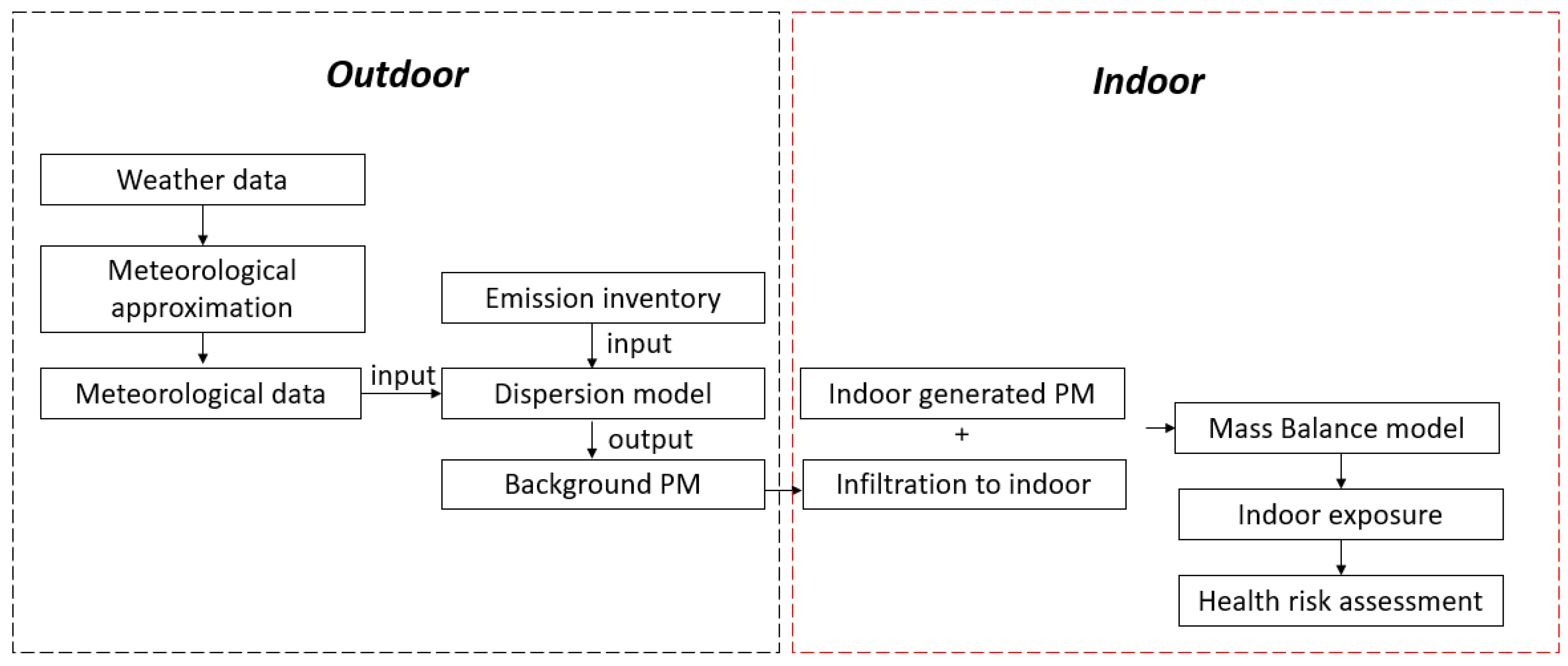
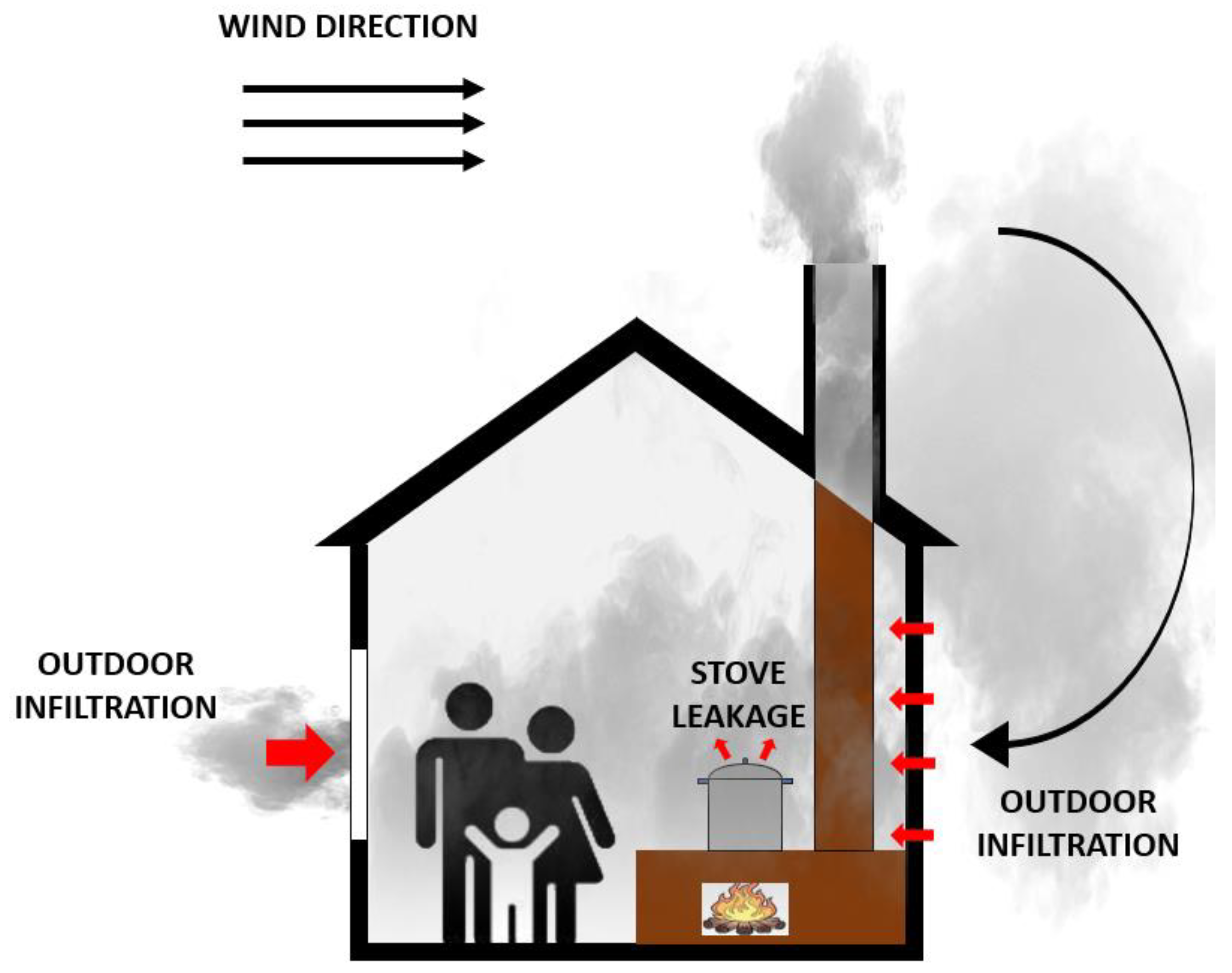
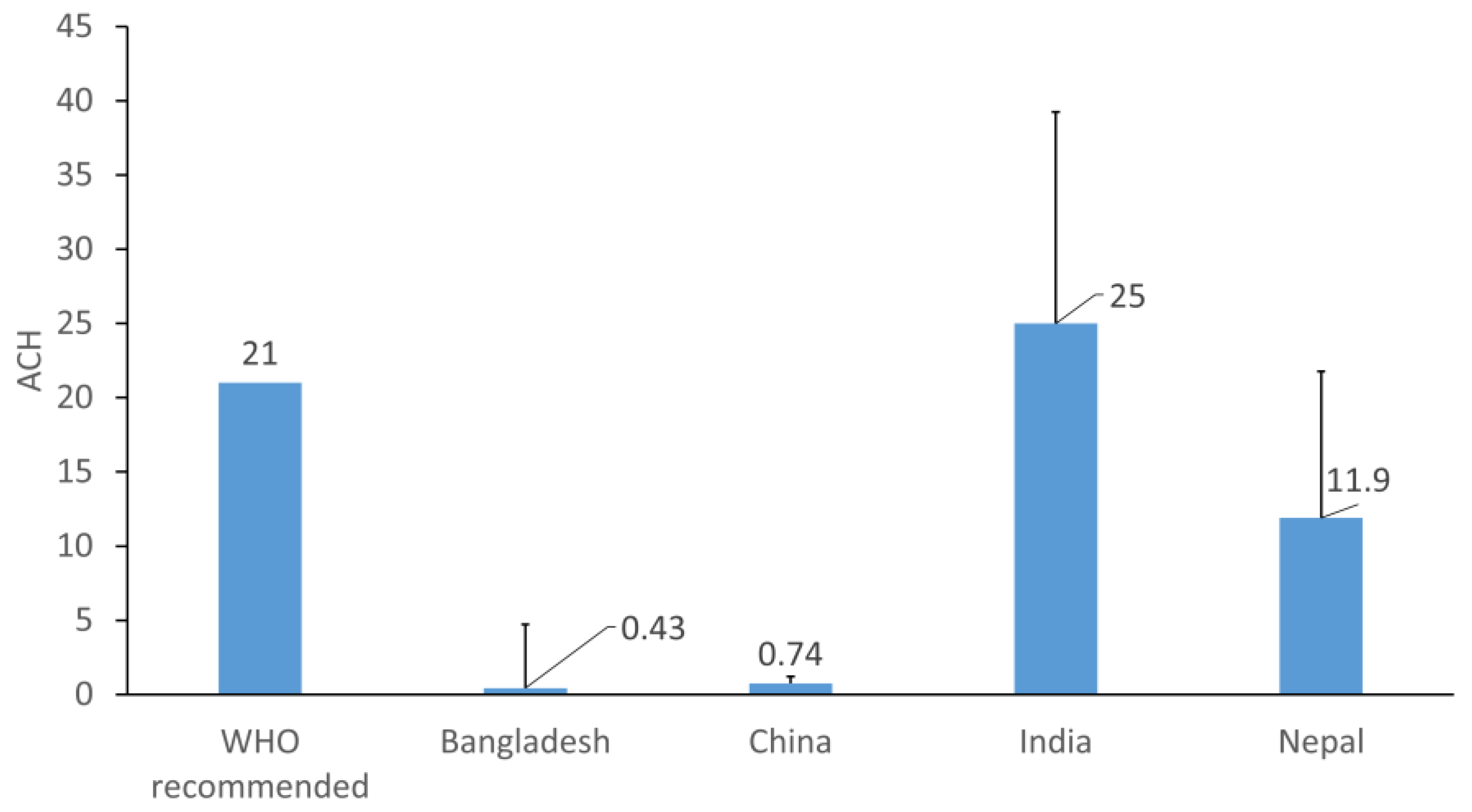



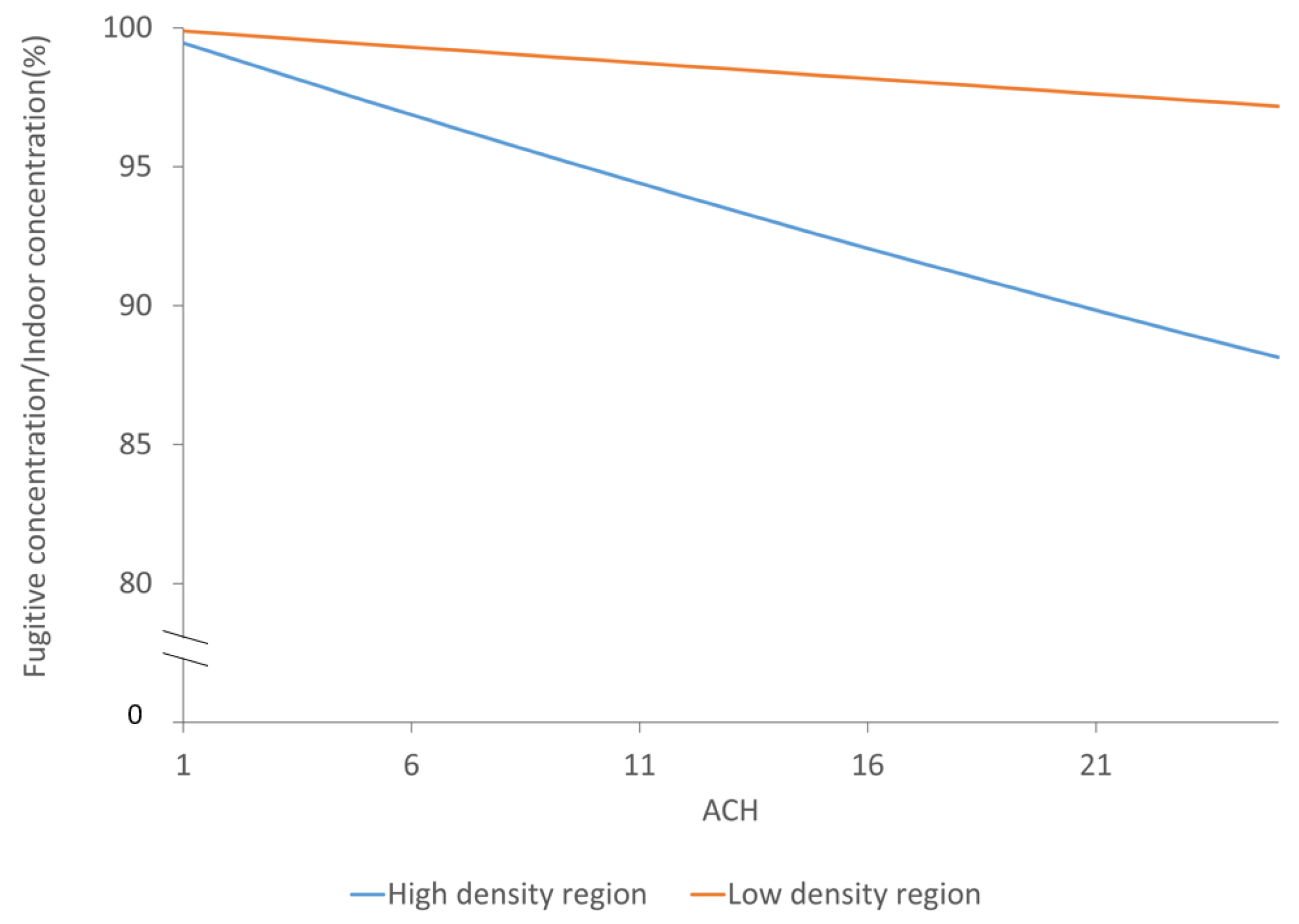
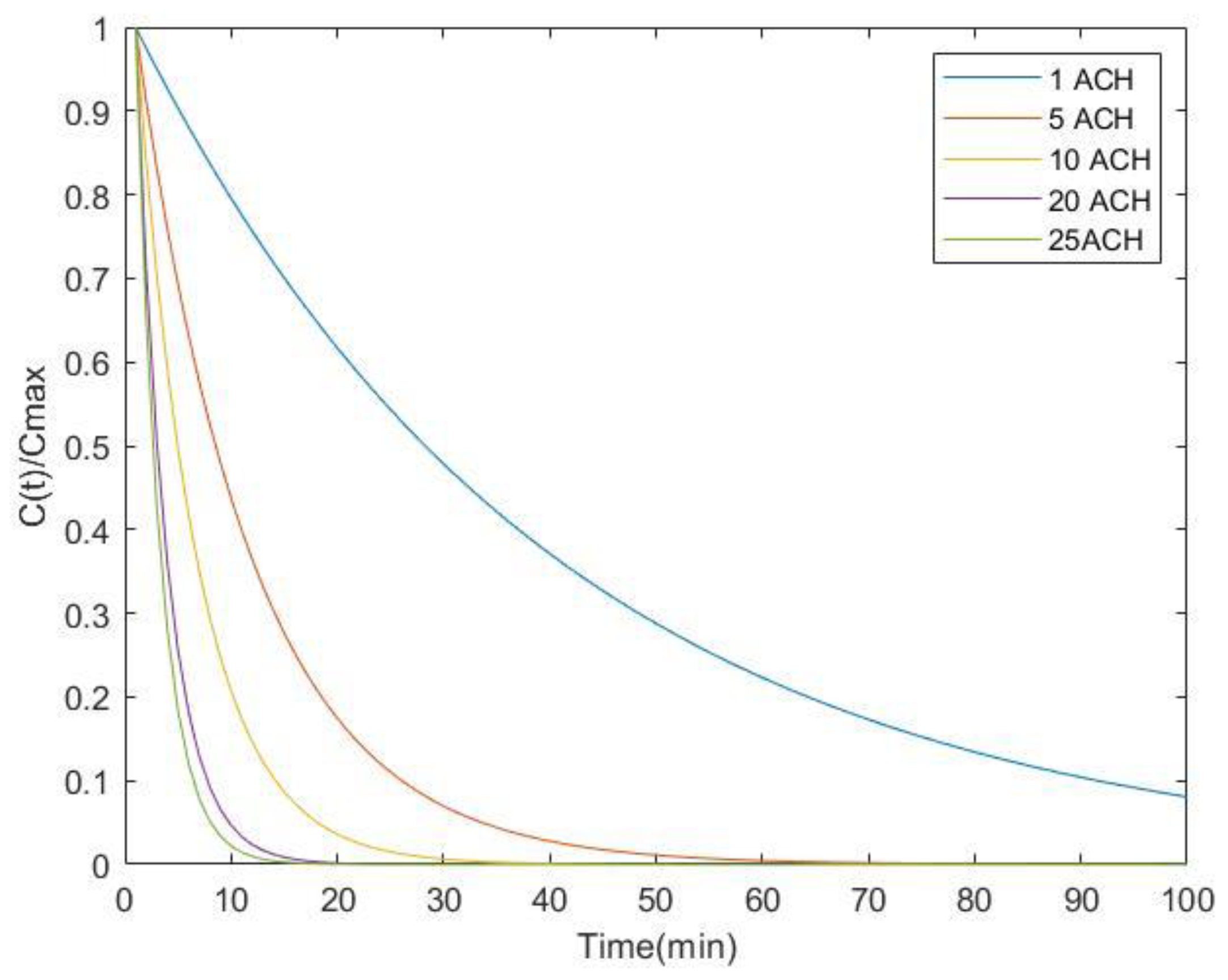

Disclaimer/Publisher’s Note: The statements, opinions and data contained in all publications are solely those of the individual author(s) and contributor(s) and not of MDPI and/or the editor(s). MDPI and/or the editor(s) disclaim responsibility for any injury to people or property resulting from any ideas, methods, instructions or products referred to in the content. |
© 2023 by the authors. Licensee MDPI, Basel, Switzerland. This article is an open access article distributed under the terms and conditions of the Creative Commons Attribution (CC BY) license (https://creativecommons.org/licenses/by/4.0/).
Share and Cite
He, Y.; Nishandar, S.R.; Edwards, R.D.; Princevac, M. Air Quality Modeling of Cooking Stove Emissions and Exposure Assessment in Rural Areas. Sustainability 2023, 15, 5676. https://doi.org/10.3390/su15075676
He Y, Nishandar SR, Edwards RD, Princevac M. Air Quality Modeling of Cooking Stove Emissions and Exposure Assessment in Rural Areas. Sustainability. 2023; 15(7):5676. https://doi.org/10.3390/su15075676
Chicago/Turabian StyleHe, Yucheng, Sanika Ravindra Nishandar, Rufus David Edwards, and Marko Princevac. 2023. "Air Quality Modeling of Cooking Stove Emissions and Exposure Assessment in Rural Areas" Sustainability 15, no. 7: 5676. https://doi.org/10.3390/su15075676
APA StyleHe, Y., Nishandar, S. R., Edwards, R. D., & Princevac, M. (2023). Air Quality Modeling of Cooking Stove Emissions and Exposure Assessment in Rural Areas. Sustainability, 15(7), 5676. https://doi.org/10.3390/su15075676






